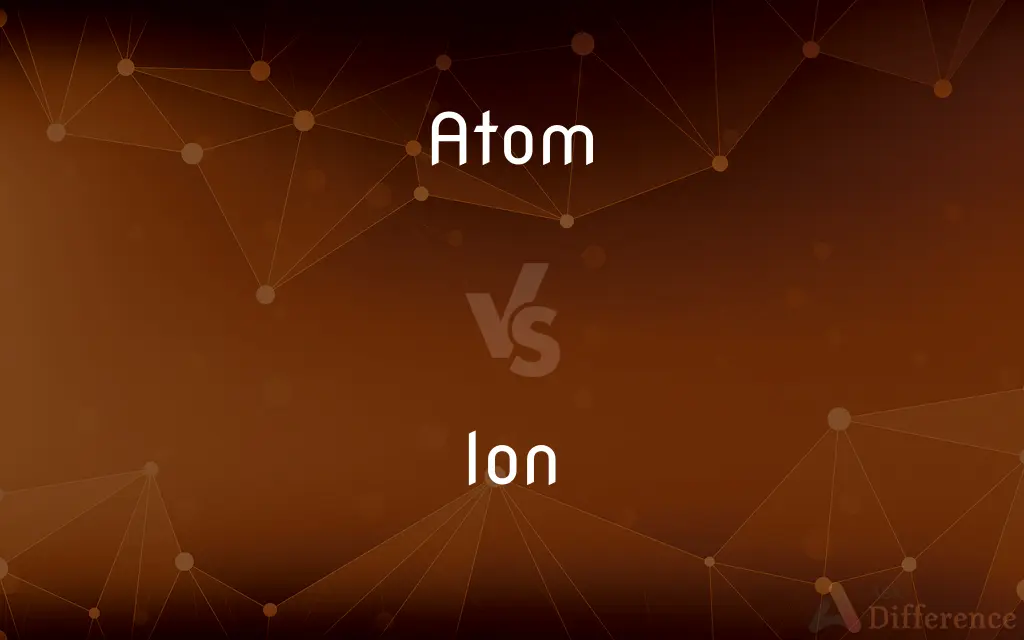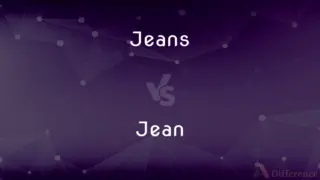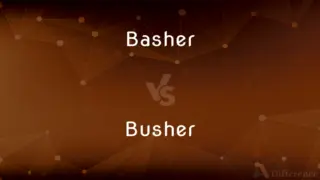Atom vs. Ion — What's the Difference?
By Fiza Rafique & Maham Liaqat — Updated on March 21, 2024
An atom is the basic unit of matter with a neutral charge, while an ion is an atom or molecule with a net electric charge due to the loss or gain of electrons.

Difference Between Atom and Ion
Table of Contents
ADVERTISEMENT
Key Differences
An atom represents the fundamental building block of matter, consisting of a nucleus surrounded by electrons. Its nucleus contains protons and neutrons, with the number of protons defining the chemical element. In its stable form, an atom has an equal number of protons and electrons, resulting in a neutral charge. On the other hand, an ion is formed when an atom or molecule either loses or gains electrons, leading to an imbalance between the number of protons and electrons and thus a net electric charge.
The formation of ions is crucial for many chemical processes, including the formation of salts and the conductance of electricity in solutions. Cations, or positively charged ions, are created when atoms lose electrons, typically metals during chemical reactions. Anions, or negatively charged ions, result from atoms gaining electrons, a common property of nonmetals. This contrasts with atoms, which in their neutral state do not participate in these types of reactions as actively.
The behavior of atoms and ions in chemical reactions highlights their differences. Atoms engage in reactions to achieve a stable electron configuration, often through the sharing of electrons in covalent bonds or the exchange in ionic bonds. Ions, already possessing a charge, readily participate in ionic bonding, attracting oppositely charged ions to form stable compounds. This inherent reactivity of ions is a key distinction from the relatively stable nature of neutral atoms.
In terms of identification and notation, atoms are identified by their element's symbol, with the atomic number representing the number of protons. Ions, however, are denoted by the element's symbol followed by a superscript indicating the charge and, if necessary, the number of charges. For example, a sodium ion with a loss of one electron is represented as Na⁺, whereas a chlorine atom gaining an electron becomes a chloride ion, Cl⁻.
Understanding the distinction between atoms and ions is fundamental in the study of chemistry and physics, as it underpins the mechanisms of chemical reactions, the properties of materials, and the structure of the universe at a microscopic level. Whether in the form of neutral atoms or charged ions, these particles play integral roles in the composition and behavior of all matter.
ADVERTISEMENT
Comparison Chart
Charge
Neutral (equal number of protons and electrons).
Positive or negative (unequal number of protons and electrons).
Formation
Exists inherently as the basic unit of matter.
Formed by the loss or gain of electrons.
Types
Defined by the number of protons.
Cations (positive) and Anions (negative).
Role in Reactions
Participates by sharing or exchanging electrons to achieve stability.
Readily engages in ionic bonding due to existing charge.
Notation
Symbol of the element (e.g., O for oxygen).
Element symbol with charge superscript (e.g., O²⁻).
Compare with Definitions
Atom
The basic building block of matter, neutral in charge.
A hydrogen atom consists of one proton and one electron.
Ion
An atom or molecule with a net electric charge due to the loss or gain of electrons.
A chlorine atom becomes a Cl⁻ ion by gaining an extra electron.
Atom
Characterized by its atomic number, the number of protons in its nucleus.
The atomic number of carbon is 6, indicating six protons.
Ion
Cations are positively charged ions formed by losing electrons.
A magnesium atom loses two electrons to form a Mg²⁺ cation.
Atom
Neutral atoms become ions by losing or gaining electrons.
A sodium atom becomes a Na⁺ ion by losing one electron.
Ion
Anions are negatively charged ions formed by gaining electrons.
A sulfur atom gains two electrons to become a S²⁻ anion.
Atom
Atoms of the same element can have different numbers of neutrons, known as isotopes.
Carbon-12 and Carbon-14 are isotopes differing in neutron count.
Ion
The charge of an ion is indicated by a superscript next to the element symbol.
Al³⁺ represents an aluminum ion that has lost three electrons.
Atom
In their stable form, atoms have a full outer electron shell or share electrons through covalent bonding.
Oxygen atoms form O₂ molecules by sharing electrons, achieving stability.
Ion
Ions are essential in the formation of ionic compounds, like salts.
Na⁺ and Cl⁻ ions combine to form sodium chloride (table salt).
Atom
An atom is the smallest unit of ordinary matter that forms a chemical element. Every solid, liquid, gas, and plasma is composed of neutral or ionized atoms.
Ion
An ion () is a particle, atom or molecule with a net electrical charge. The charge of the electron is considered negative by convention.
Atom
A part or particle considered to be an irreducible constituent of a specified system.
Ion
An atom or a group of atoms that has acquired a net electric charge by gaining or losing one or more electrons.
Atom
The irreducible, indestructible material unit postulated by ancient atomism.
Ion
An atom or group of atoms bearing an electrical charge, such as the sodium and chlorine atoms in a salt solution.
Atom
An extremely small part, quantity, or amount.
Ion
An atom or goup of atoms (radical) carrying an electrical charge. It is contrasted with neutral atoms or molecules, and free radicals. Certain compounds, such as sodium chloride, are composed of complementary ions in the solid (crystalline) as well as in solution. Others, notably acids such as hydrogen chloride, may occur as neutral molecules in the pure liquid or gas forms, and ionize almost completely in dilute aqueous solutions. In solutions (as in water) ions are frequently bound non-covalently with the molecules of solvent, and in that case are said to be solvated. According to the electrolytic dissociation theory, the molecules of electrolytes are divided into ions by water and other solvents. An ion consists of one or more atoms and carries one unit charges of electricity, 3.4 x 10-10 electrostatic units, or a multiple of this. Those which are positively electrified (hydrogen and the metals) are called cations; negative ions (hydroxyl and acidic atoms or groups) are called anions.
Atom
The smallest unit of an element, having all the characteristics of that element and consisting of a very small and dense central nucleus containing protons and neutrons, surrounded by one or more shells of orbiting electrons. Atoms remain undivided in chemical reactions except for the donation, acceptance, or exchange of valence electrons.
Ion
One of the small electrified particles into which the molecules of a gas are broken up under the action of the electric current, of ultraviolet and certain other rays, and of high temperatures. To the properties and behavior of ions the phenomena of the electric discharge through rarefied gases and many other important effects are ascribed. At low pressures the negative ions appear to be electrons; the positive ions, atoms minus an electron. At ordinary pressures each ion seems to include also a number of attached molecules. Ions may be formed in a gas in various ways.
Atom
This unit regarded as a source of nuclear energy.
Ion
A particle that is electrically charged (positive or negative); an atom or molecule or group that has lost or gained one or more electrons
Atom
The smallest possible amount of matter which still retains its identity as a chemical element, now known to consist of a nucleus surrounded by electrons.
Atom
(history of science) A hypothetical particle posited by Greek philosophers as an ultimate and indivisible component of matter.
Atom
The smallest, indivisible constituent part or unit of something.
Atom
(philosophy) In logical atomism, a fundamental fact that cannot be further broken down.
Atom
(historical) The smallest medieval unit of time, equal to fifteen ninety-fourths of a second.
Atom
A mote of dust in a sunbeam.
Atom
A very small amount; a whit.
Atom
An individual number or symbol, as opposed to a list; a scalar value.
Atom
(mathematics) A non-zero member of a partially ordered set that has only zero below it (assuming that the poset has a least element, its "zero").
In a Venn diagram, an atom is depicted as an area circumscribed by lines but not cut by any line.
Atom
An element of a set that is not itself a set; an urelement.
Atom
An age group division in hockey for nine- to eleven-year-olds.
Atom
An ultimate indivisible particle of matter.
Atom
The smallest particle of matter that can enter into combination; one of the elementary constituents of a molecule.
Atom
Anything extremely small; a particle; a whit.
There was not an atom of water.
Atom
To reduce to atoms.
Atom
(physics and chemistry) the smallest component of an element having the chemical properties of the element
Atom
(nontechnical usage) a tiny piece of anything
Common Curiosities
How do ions contribute to electricity in solutions?
Ions in solution allow the flow of electric current by moving towards opposite electrodes, making the solution conductive.
What role do ions play in the human body?
Ions are crucial for bodily functions, including nerve impulse transmission, muscle contraction, and maintaining hydration.
Are all atoms capable of becoming ions?
Most atoms can become ions under the right conditions, particularly through chemical reactions.
How are ions detected and measured?
Ions can be detected and measured using various methods, including spectroscopy and electrochemical sensors.
What is ionization energy?
Ionization energy is the energy required to remove an electron from an atom or ion, turning it into a cation.
Can the formation of ions be reversible?
Yes, ion formation can be reversible, often through chemical reactions where ions can gain or lose electrons.
Can molecules also become ions?
Yes, molecules can become ions, typically through the loss or gain of electrons, resulting in molecular ions.
Are ions always single atoms?
No, ions can be single atoms or molecules that have gained or lost electrons, known as polyatomic ions.
What determines whether an ion is positive or negative?
An ion's charge depends on whether it loses electrons (positive) or gains electrons (negative).
Can an atom become an ion and then return to being an atom?
Yes, through chemical reactions, ions can gain or lose electrons to return to a neutral atomic state.
What is an isotope?
An isotope is a variation of an element's atom with the same number of protons but a different number of neutrons.
What is an electrolyte?
An electrolyte is a substance that produces an electrically conducting solution when dissolved, often containing ions.
Why do atoms form ions?
Atoms form ions to achieve a more stable electron configuration, often resembling the nearest noble gas.
How do ionic and covalent bonds differ?
Ionic bonds form between oppositely charged ions, while covalent bonds involve the sharing of electrons between atoms.
How do ions affect the pH of a solution?
Ions, particularly H⁺ and OH⁻, directly influence a solution's acidity or alkalinity, thus affecting its pH.
Share Your Discovery

Previous Comparison
Jeans vs. Jean
Next Comparison
Basher vs. BusherAuthor Spotlight
Written by
Fiza RafiqueFiza Rafique is a skilled content writer at AskDifference.com, where she meticulously refines and enhances written pieces. Drawing from her vast editorial expertise, Fiza ensures clarity, accuracy, and precision in every article. Passionate about language, she continually seeks to elevate the quality of content for readers worldwide.
Co-written by
Maham Liaqat













































